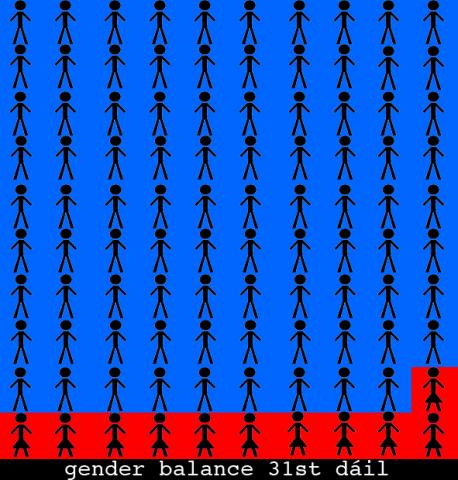Our unbalanced Dáil

Ireland’s seventh place ranking out of 187 countries in the annual UN Human Development Report puts the country ahead of the majority of its EU neighbors when it comes to gains in education, health and income. Of the EU 27, only the Netherlands ranks higher, in third place. But when the index is adjusted for gender inequality, Ireland’s ranking plunges 26 places to 33.
The Gender Inequality Index adjusts for access to reproductive health, education, political participation and employment. It’s in the political participation category where Ireland really takes a hit. The report says women occupy only 11.1% of seats in parliament, less than half the EU average of 23%. In fact, only four EU countries - Hungary, Malta, Romania and Slovenia - have lower female parliamentary representation, according to the report. Globally, countries such as Jordan, Niger and Swaziland have a greater percentage of female legislators than Ireland. In the labour force, the report says 54% of Irish women are employed compared with 73% of men, while girls edge out boys when it comes to educational attainment - 82.3% of girls and 81.5% of boys finish secondary school.
A second report released this week, the World Economic Forum’s Global Gender Gap 2011, is more comforting. It places Ireland fifth out of the 135 countries it measures. But, that report includes a variable for number of years out of the past fifty that the country has had a female head of state or government. Bonus points to Ireland here, though the index does not adjust for executive powers, of which the Irish president has little.
That WEF report also reveals another interesting statistic: while women comprise more than 83% of primary school teachers, that share drops to 38% when it comes to women teaching at third level institutions, despite more Irish women graduating from college than men. The report also says more Irish women are unemployed as a percentage of the labor force than men.
Irish women live longer than their male counterparts with an average life expectancy of 74 compared with 71 for men, the report says. It also says 66% of girls go on to third level education compared with 51% of boys. The average age of marriage for women is 31 and average number of children is two.
If there’s a bottom line in all these statistics, it’s that Irish women outperform Irish men in education but cannot dislodge men from political power. In a week when the modern symbolic seat of female political representation in Ireland - the presidency - has been lost, it’s time to address the obvious political inequalities that separate Ireland from most of the EU and, indeed, the world. The answer lies in a quota system. Quotas have worked in countries as diverse as Sweden and Rwanda (both have about 45% female parliamentary representation). There’s no reason why it wouldn’t work in Ireland. {jathumbnailoff}
Image top: Eadaoin O'Sullivan.
